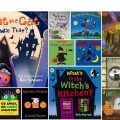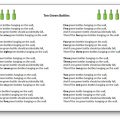Author: Ed Emberley
Illustrator: Ed Emberley
Publisher: Little, Brown and Company
Year: 1992
Language: English
Type of resource: Illustrated picture book
Themes: Fear, emotions, body parts, self-confidence
Age range: 3–7 years old
School levels: Preschool and early elementary (K–Grade 1)
Main learning objective: Develop listening comprehension and the ability to express emotions in English
Language objective in English: I can name parts of the face and give simple commands like “Go away, nose!”
Summary of the Book
Go Away, Big Green Monster! is an interactive picture book in which a scary monster gradually appears before the reader’s eyes. Each page adds a new part of the monster’s face, described with simple English vocabulary: yellow eyes, bluish-greenish nose, ears, a big red mouth with sharp white teeth, purple hair… But halfway through the book, the child takes control and begins to make the monster disappear, part by part, using assertive imperative sentences. In the end, the monster is gone — and won’t come back “until I say so!”
Culture and Vocabulary
Fear of monsters is a universal childhood theme, and this book presents it in a fun and reassuring way. It also offers a narrative of empowerment, where the child overcomes fear and takes charge. This can be tied into themes of emotional literacy, self-esteem, and expressing feelings.
Facial features: eyes, nose, mouth, teeth, ears, hair, face
Color adjectives: yellow, bluish-greenish, red, white, purple, green
Size and shape adjectives: big, little, sharp, scary, squiggly, scraggly
Action verbs: go away, don’t come back
Key expressions: “You don’t scare me!”, “until I say so”
Grammar and Structures
- Simple present with “has”: “Big Green Monster has two big yellow eyes.”
→ This structure reinforces vocabulary for facial features using the pattern: subject + has + noun phrase. - Descriptive adjective order: “a long bluish-greenish nose”
→ A good opportunity to explore how English adjectives follow a specific order before the noun. - Affirmative imperative: “Go away, sharp white teeth!”
→ This is the central structure repeated throughout the book, making it ideal for introducing the imperative in a rhythmic and engaging way. - Negative imperative: “Don’t come back!”
→ A strong emotional sentence that introduces the negative form of the imperative. - Exclamatory sentences: “YOU DON’T SCARE ME!”
→ A bold expression children can use to express feelings and build confidence in speaking English.
Phonology
This book is highly rhythmic and rich in sound patterns, making it ideal for oral work:
- Repetition of [g] sounds: go, green, go away
- Assonance and alliteration: big green face, scary sharp teeth
- Intonation and rhythm of commands and exclamations help with prosody
- Contrasts in sounds: nose vs mouth, ears vs eyes
- Vowel sounds in colors: green, yellow, red
- Voiced/voiceless sounds [s] and [z]: nose, eyes, teeth
Teaching Suggestions
Before Reading:
- Show the cover and make predictions with students
- Introduce facial feature vocabulary using flashcards, drawings or mirrors
- Explore emotions like fear and courage with facial expressions
During Reading:
- Read expressively and act out each page
- Point to facial parts on your face or a drawing
- Have students repeat the “Go away…” structures together
After Reading:
- Have students draw their own monsters and describe them in English
- Use puppets to act out “Go away…” commands
- Set up a short theatre or roleplay session about fears
Grammar Mini-Lesson: Focus on the imperative structure. Write examples on the board (“Go away, ears!”, “Don’t come back!”). Practice with gestures or roleplay. Have students give commands using classroom objects or their drawings: “Go away, pencil!”, “Go away, scary monster!” Reinforce pronunciation and rhythm through chants.
Differentiation
For non-readers, this book works perfectly in oral activities with visual support (posters, puppets, drawings). For more advanced students (ages 6–8), a guided writing task could involve inventing a new monster with personalized features. Students with special educational needs will benefit from the repetitive structure and physical engagement.
Cross-Curricular Connections
Music: Work on rhythm and intonation with body percussion; songs like “Head, Shoulders, Knees and Toes” or “If You’re Happy and You Know It”
Civic Education: Discuss and express fears, emotions, and self-confidence
Art: Create monster masks inspired by the book
Media Education: Compare different monster images from books or cartoons
Drama / Roleplay: Act out the story using costumes or props
Games: Memory games with facial parts
Project Ideas
Art and Language Project: “My Own Monster” – Each child creates a personalized paper monster (cut-out eyes, nose, mouth, etc.) and writes or records a short description in English. Create a classroom exhibit and audio station to showcase their work.
Related Books: Explore other books on emotions and fears such as There’s a Monster in Your Book or The Colour Monster (Amazon Affiliate Links).
Conclusion
Go Away, Big Green Monster! is a perfect first read-aloud in English for young learners. Its repetitive structure, accessible vocabulary, and strong image-text interaction make it ideal for use in preschool and early primary classes. It deals with fear in a humorous, empowering way while building essential language skills. It encourages speaking, listening, creativity, and emotional expression in a safe and playful environment.





